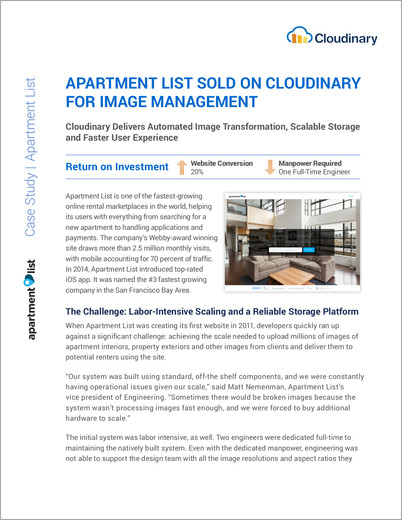Apartment List is one of the fastest-growing online rental marketplaces in the world, helping its users with everything from searching for a new apartment to handling applications and payments. The company’s Webby-award winning site draws more than 2.5 million monthly visits, with mobile accounting for 70 percent of traffic. In 2014, Apartment List introduced top-rated iOS app. It was named the #3 fastest growing company in the San Francisco Bay Area.
When Apartment List was creating its first website in 2011, their developers quickly ran up against a significant challenge: achieving the scale needed to upload millions of images of apartment interiors, property exteriors and other images from clients and deliver them to potential renters using the site.
“Our system was built using standard, off-the shelf components, and we were constantly having operational issues given our scale,” said Matt Nemenman, Apartment List’s vice president of Engineering. “Sometimes there would be broken images because the system wasn’t processing images fast enough, and we were forced to buy additional hardware to scale.”
The initial system was labor intensive, as well. Two engineers were dedicated full-time to maintaining the natively built system. Even with the dedicated manpower, engineering was not able to support the design team with all the image resolutions and aspect ratios they required. “One of the main things we needed was different sizes of images to serve them to mobile devices, desktops, phones of different sizes and different operating systems. But every time our team would redesign the site, we’d run into major problems with photo sizes,” Nemenman noted. “With more than 23 million photos in use every day, it was time- consuming to have to reprocess all of those.”
Storage was another concern. Apartment List received thousands, sometimes millions, of images at a time, so it needed a reliable storage platform that could handle the library of images and properties listed on the sight as it grew.
After about six months of attempting to get its system to work seamlessly, Apartment List decided to revisit its processes and find a better solution for image management. Enter Cloudinary.

“Cloudinary gave us an end-to-end solution that provides us the storage we needed, while automating image transformation and supporting faster delivery,” said Nemenman.
Cloudinary enables Apartment List to effectively take any image format – JPEGs, PNGs and others – in a variety of resolutions, and transform them all into a format that works best for each browser or mobile client. Apartment List picks up data feeds of images from all of the apartment communities featured on its site, and uploads them into Cloudinary. After being given a unique ID, each image undergoes different transformations so it can be used in mobile and desktop versions of the site.
With Cloudinary, Apartment List also is able to filter out low quality images (low resolution, pictures of people faces, logos, etc.) and label pictures to help identify the features of the apartments being shown.
During the first three years of use, Apartment List has seen tangible results from its
use of Cloudinary. After a smooth, short transition from its home-grown system to Cloudinary’s cloud-based solution, Nemenman estimates that the automation has saved the equivalent of one full-time engineer managing day-to-day operations, and thousands of man-hours required previously to transform images.
“Cloudinary has allowed us to solve our operational issues, produce various resolutions of images and cache them at endpoints closer to the end user for an optimal user experience,” said Nemenman, noting that after launching its native iOS app in 2015, Apartment List received positive feedback about how fast images loaded.
Apartment List also credits Cloudinary, in part, with conversion rates that increased nearly 20 percent after a redesign of its listing detail page. “We moved to a responsive design, and that would not have been possible without Cloudinary,” Nemenman concluded, adding that “Cloudinary offers one of those great services, which we implemented three years ago and have been using happily ever after.”

